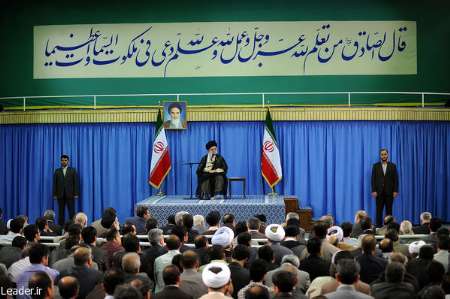ID :
334207
Thu, 07/03/2014 - 08:35
Auther :
Shortlink :
https://oananews.org/index.php//node/334207
The shortlink copeid
S. Leader: Iranˈs Scientific Movement To Continue Non-stop

Tehran, July 3, IRNA – Supreme Leader of Islamic Revolution said here Wednesday that rapid and serious trend of Iranian scientific movement must continue non-stop based on proper and revolutionary management.
Ayatollah Seyyed Ali Khamenei made the remark in a meeting with hundreds of Iranian university professors from faculties of technical, cultural, economic, and human sciences from different Iranian universities in the course of a meeting that took over two hours.
In the beginning of the meeting seven university professors elaborated on the status quo of the Iranian scientific movement, its points of strength and the challenges it is faced with.
Ayatollah Khamenei said that his meetings with the university professors are among the most pleasant ones he as with different groups representing the Iranian society, highlighting the importance of preserving the exalted prestige of the countryˈs scientific and intellectual elite.
His eminence stressed that the great significance of keeping up the rapid pace of the countryˈs scientific movement is due to the fact that it is a main factor in shaping up both Iranˈs future fate and that of the Islamic world.
The leader said that ˈsome of theˈ comments made by the representatives of the Iranian university professors in the meeting were very useful and constructive and they needed to be used both in the consultations, and in the academic and scientific planning of the countryˈs concerned officials.
ˈAfter many years of making emphasis on the need for serious scientific work, the countryˈs scientific movement has achieved great objectives and is even recognized at international scenes, enabling us to say that it has been globally unveiled,ˈ said Ayatollah Khamenei.
He expressed serious concern that such a successful, prestigious, and beneficial movement that is the fruit of several years of serious endeavors of the selfless Iranian scientists, technicians and thinkers would God forbid, in its half-way to full success, be slowed down, or halted.
ˈAny type of pause, or slowing down in the accelerating trend of the countryˈs scientific engine will also lead to its recession,ˈ said the leader.
Ayatollah Khamenei said that if this scientific movement and our scientistsˈ endeavor for conquering new peaks of scientific success would be halted or slowed down then putting it back on the rail of progress would be very difficult, and therefore, everyone must contribute full-scale to the countryˈs scientific progress.
After the Iranian Revolution, there have been efforts by the new political system in the country to make up for the countryˈs backwardness in keeping pace with the advancement of the modern science in the world.
This is seen by some as the reason behind the recent successes of Iran to augment its scientific output.
Currently Iran aims for a national goal of self sustainment in all scientific arenas. Many individual Iranian scientists, along with the Iranian Academy of Medical Sciences and Academy of Sciences of Iran, are involved in this revival. The Comprehensive Scientific Plan has been devised based on about 51,000 pages of documents and includes 224 scientific projects that must be implemented by the year 2025.
Iranˈs national science budget was about $900 million in 2005 and it had not been subject to any significant increase for the previous 15 years. By early 2000, Iran allocated around 0.4% of its GDP to R&D, which ranked it ˈfar behind industrialized societiesˈ and the world average of 1.4%.
By 2009 this ratio of research to GDP reached 0.87% and the set target is 2.5% to be reached by 2015.
Iranˈs government has devoted huge amounts of funds for research on high technologies such as nanotechnology, biotechnology, stem cell research and information technology (2008).
Iranian Research Organization for Science and Technology and the National Research Institute for Science Policy are two of the main institutions, depending on the Ministry of Science, Research and Technology, in charge of establishing research policies at the state level.
In 2006, Iranian government wiped out the financial debts of all universities in a bid to relieve their budget constraints.
According to UNESCO science report 2010, most of the research in Iran is government funded with the Iranian government providing almost 75% of all research findings. The share of private businesses in total national R&D funding according to the same report is very low being just 14% as compared with the Turkeyˈs 48%. The rest of approximately 11% of funding comes from higher education sector and non-profit organizations.
In 2009, Iranian government formulated a 15-year comprehensive national plan for science focused on higher education and strengthening the links between academia and industry in order to promote a knowledge based economy.
As per the plan by year 2030, Iranˈs research and development spending is to be increased to 4% of GDP from 0.59% of 2006 and increasing its education spending to over 7% of GDP from the 2007 level of 5.49%./end





